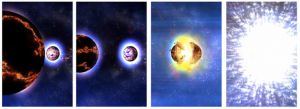 We propose that the major 2012 outburst of the supernova impostor SN 2009ip was powered by an extended and repeated interaction between the Luminous Blue Variable (LBV) and a more compact companion. Motivated by the recent analysis of Margutti et al. (2013) of ejected clumps and shells we consider two scenarios. In both scenarios the major 2012b outburst of ~5 * 10^{49} erg was powered by accretion of ~ 2-5 solar masses onto the companion during a periastron passage (the first passage) of the binary system approximately 20 days before the observed maximum of the light curve. In the first, the surviving companion scenario, the companion was not destructed and still exists in the system after the outburst. It ejected partial shells (or collimated outflows or clumps) for two consecutive periastron passages after the major one. The orbital period was reduced from ~38 days to ~25 days as a result of the mass transfer process that took place during the first periastron passage. In the second, the merger scenario, some partial shells/clumps were ejected also in a second periastron passage that took place ~20 days after the first one. After this second periastron passage the companion dived too deep into the LBV envelope to launch more outflows, and merged with the LBV.
We propose that the major 2012 outburst of the supernova impostor SN 2009ip was powered by an extended and repeated interaction between the Luminous Blue Variable (LBV) and a more compact companion. Motivated by the recent analysis of Margutti et al. (2013) of ejected clumps and shells we consider two scenarios. In both scenarios the major 2012b outburst of ~5 * 10^{49} erg was powered by accretion of ~ 2-5 solar masses onto the companion during a periastron passage (the first passage) of the binary system approximately 20 days before the observed maximum of the light curve. In the first, the surviving companion scenario, the companion was not destructed and still exists in the system after the outburst. It ejected partial shells (or collimated outflows or clumps) for two consecutive periastron passages after the major one. The orbital period was reduced from ~38 days to ~25 days as a result of the mass transfer process that took place during the first periastron passage. In the second, the merger scenario, some partial shells/clumps were ejected also in a second periastron passage that took place ~20 days after the first one. After this second periastron passage the companion dived too deep into the LBV envelope to launch more outflows, and merged with the LBV.
Authors: Amit Kashi (UNLV), Noam Soker (Technion), Nitsan Moskovitz (Technion)

